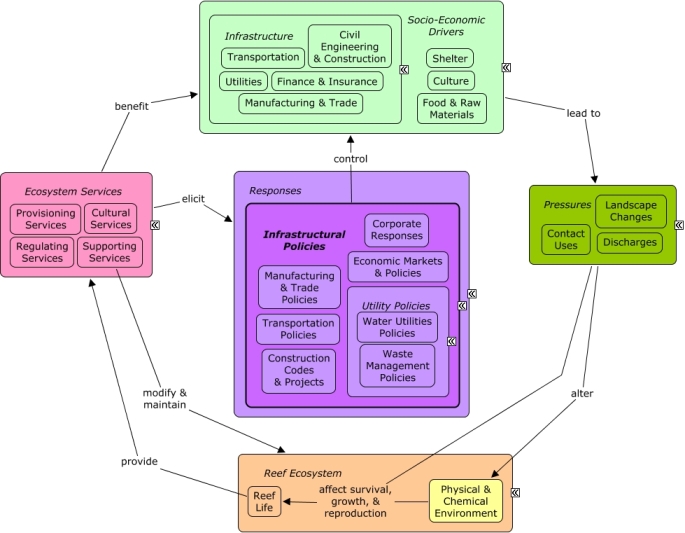ReefLink Database

Infrastructural Policies
Infrastructural policies are responses, including zoning, codes, or regulations, that impact the distribution and functioning of socio-economic sectors that provide infrastructure. Examples include policies to manage transportation, regulations on manufacturing and trade, construction codes and regulations, construction projects, economic policies and market pressures, and responses by individual corporations.
CMap

CMap Description
A change in the provision of ecosystem services, or a desire to improve provision of ecosystem services, may elicit responses to manage the distribution and functioning of socio-economic sectors which provide infrastructure. Infrastructure sectors, including transportation, utilities, construction, and manufacturing, create pressures on the reef ecosystem primarily through pollutant discharges and landscape changes, including devegetation, impervious surfaces, and soil disturbance which can effect rates of pollutant runoff. In coastal areas, development may require shoreline armoring or dredging activities, which can directly impact coastal vegetation and alter patterns of waterflow. Transportation management includes policies, regulations, and zoning designed to control the distribution and intensity of transportation networks, including roads and shipping channels, and vehicles, including cars, boats, and ships. Manufacturing regulations control activities of factories, such as requiring technology upgrades to reduce discharges. Trade regulations influence the sell of certain items, and can be targeted to protect endangered species, or encourage sell of sustainable species. Construction codes and regulations control the location, number, and development of construction projects, including buildings, homes, and coastal structures. Economic markets and policies can influence financing and insurance, as well as drive consumer demand for certain types of goods and services. Consumer demand can pressure corporations to change their behavior or adopt environmentally friendly practices. Infrastructure sectors benefit from reef ecosystem services, including shoreline protection, the availability of seafood, and recreational opportunities which drive coastal development and the need for infrastructure.Citations
More than 50 citations. Click here to load.
| Citation | Year | Study Location | Study Type | Database Topics |
|---|
Management Options
More than 50 management options. Click here to load.
| Management Option | Description | Sources | Database Topics |
|---|
Laws
More than 50 laws. Click here to load.
| Legal Citation | Purpose of Law | Management Organization | Database Topics |
|---|
